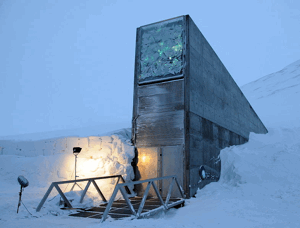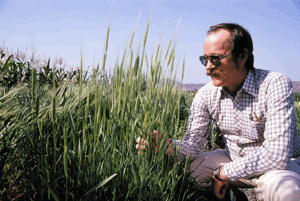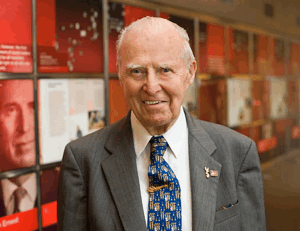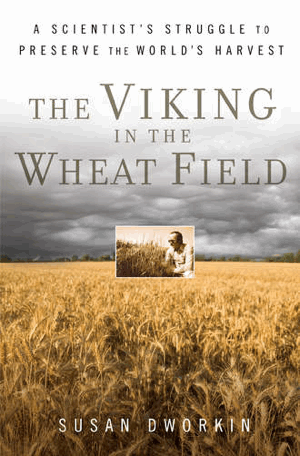Seeds of Resistance
Air Date: Week of March 12, 2010

The main entrance to the Svalbard Global Seed Vault. (Photo: Wikimedia Commons)
A small group of plant scientists work tirelessly around the world to keep plant disease at bay. Now, they’re trying to find a strain of wheat resistant to stem rust, which is threatening the world’s wheat supply. Host Jeff Young talks with author Susan Dworkin whose book, “The Viking in the Wheat Field: A Scientist’s Struggle to Preserve the World’s Harvest,” follows the life of a man who was devoted to saving seeds from plants all over the world so that we will be able to fight future diseases.
Transcript
YOUNG: It’s Living on Earth, I’m Jeff Young. Bread, pasta, pita, tortillas: wheat feeds the world – providing a quarter of humanity’s calories. Yet those who devote their careers to protecting this vital crop largely toil in obscurity. Biographer Susan Dworkin wants to change that. Her new book is “Viking in the Wheat Field: A Scientist’s Struggle to Preserve the World’s Harvest.” It focuses on one scientist’s work to save the diversity of wheat plants. And Ms. Dworkin begins her story with a current – and alarming – example of why we need that diversity. She tells us about a wheat pest first spotted in Uganda called Ug99.
DWORKIN: Ug99 is a variety of disease called stem rust. Which is the most pernicious and terrible disease of wheat. And since wheat gives us 25 percent of the world’s calories, any disease that is that dangerous to the wheat crop is something we must be very concerned about.
YOUNG: Where is this disease now?
DWORKIN: It’s a fungal disease, which is spread by spores and these spores blow on the wind. So there’s no way to control where the wind blows, and the wind blew the spores of Ug99 into Kenya, and then it blew the spores across the Red Sea into Yemen, and then it blew the spores north up the Arabian Peninsula into Iran where it has currently taken hold and where they’ve had terrible losses in the wheat crop because of this terrible disease. Now if it moves out of Iran and it moves into India and Pakistan, which gives us 20 percent of the world’s wheat, once it jumps the Himalayas it gets to China, the next stop is the Ukraine, Kansas, France, the world.
YOUNG: We’re talking about the staff of life, here –
DWORKIN: That’s right.
YOUNG: Wheat. You’d think I’d have heard of it. How is it we’ve not heard about this?
DWORKIN: Because there’s a terrible information gap in our country. The farmers have heard about it, the United States Department of Agriculture has heard about it, but the vast majority of Americans who just eat haven’t heard about Ug99. In fact, they haven’t heard about any major agricultural issue.
YOUNG: So what’s our defense, what do we do about a disease like this?

The main entrance to the Svalbard Global Seed Vault. (Photo: Wikimedia Commons)
DWORKIN: A number of scientists from 40 different countries get together and they have begun looking for traits that would impart resistance to the wheat and immunity. The way to do that is to look into this network of seed banks, which we have in this world for every crop from apples to flax – these are collections of traits and genes from different varieties of this crop. And when you need to find a new trait to breed into the old wheat to meet a new stress like Ug99 – you go into the gene banks and you look around for the right traits, and then you re-breed the crop. And the man who I wrote about in “The Viking in the Wheat Field” was the greatest gene banker that we’d had in the world, and his name was Bent Skovmand, and he was an expert.

Bent Skovmand (Photo: Skovmand Collection)
YOUNG: What was it in his work that made him realize the importance of expanding and protecting these seed banks?
DWORKIN: He went to work for a man named Norman Borlag, who won the Nobel Prize for the Green Revolution, which distributed seed during the ‘60s to places where there was endemic famine. Skovmand was like all the disciples of Borlag primarily a hunger-fighter. These were people who really believed that endemic famine was not necessary in this world. That India, which had a famine that killed five million people every 15 years, that that didn’t have to happen. That if you could reorganize local agriculture, and provide the kinds of wheat that would resist bugs like Ug99, or drought, or frost that local agriculture could feed the people and prevent famine.
YOUNG: You recount a lot their work, and a lot of the wheat varieties that we take for granted came about through amazing happenstance.
DWORKIN: Right. I’ll tell you the story: there was a very great plant collector named Jack Harlan, who worked for the Department of Agriculture in the ‘40s and ‘50s. And he was out looking for wheat varieties in Turkey one day. And there was one plant that was the ugliest – he says, ugly, downtrodden, kind of smooshy plant that didn’t have any elegance to it, and he said – uch, I’m going to put it in the bag, too. Some years later, there as a terrible outbreak of rust in the Pacific Northwest – really decimated the wheat crop. And the plant that had the resistance to the new strain was this ugly, horrible plant that Harlan had put into his sack in Turkey.

Norman Borlaug during his visit to the Nobel Peace Center on 1 September 2006. (Photo: Trond Isaksen, Copyright © Nobel Peace Center 2006)
YOUNG: It’s like the wheat version of the “Ugly Duckling” or something?
DWORKIN: Exactly, exactly.
YOUNG: So, the lesson here is save everything.
DWORKIN: Save everything. And that’s what Skovmand always said.
YOUNG: How are we doing, though, in terms of saving everything when there’s such drive for monoculture, to just grow one thing and plow everything with that one crop?
.gif)
Norman Borlaug (Photo:CIMMYT)
DWORKIN: The truth is that business loves monoculture, nature loves diversity. The reason we have monocultures of such enormous acreage in our country is because when a crop is profitable all farmers want to plant it, and the major corporations want to sell it. On the other hand, if you have fewer and fewer varieties, if you have a smaller and smaller genome with which to rebreed the crop when disaster strikes.
YOUNG: But what about as climate change begins to take effect. Is the variety that we have in a seed bank going to help us when the weather changes in our breadbasket?

DWORKIN: Yes, it is. Global warming changes the environment in which the plant lives. So if you need to have wheat for example in Australia where there’s been terrible drought, you’re going to go look in a gene bank, you’re going to find a wheat that grew in Mexico in desert conditions, you’re going to take some genes from that variety, put it into the Australian wheat, and that’s how you will defend the Australia crop against global warming.
YOUNG: Mr. Skovmand was clearly visionary when it came to saving seeds. He also was one of the early people to see this tension that was arising between keeping this information public versus the desire by corporations to make it private.
DWORKIN: In 1980 the Supreme Court ruled that forms of life could be patented and held privately. That meant that the great corporations in the chemical business had a kind of leg up on the seed business because they could reinvent seeds with new qualities and new traits, based on what they knew of chemistry. Skovmand was very much against the patenting of life forms. He said, patenting a gene was like patenting every word in “Hamlet”; you’d have to pay Shakespeare every time you used a word in “Hamlet”. So, to, that’s a nickel; be, that’s another nickel; or, that’s another nickel, right? To him it was insane because it has narrowed agricultural research to those crops which bring a profit. So nobody’s doing research to increase the genetic wealth of sorghum or cassava, which are the staples of the developing world. Whereas corn and soybeans and cotton – those crops are very, very much worked on by the private sector.
YOUNG: So, what do you think is the takeaway lesson from learning about Mr. Skovmand’s life and work?
DWORKIN: The takeaway lesson for me, and I’m an urban woman, I am a New Yorker, was that we can no longer allow agriculture policy to be made essentially in secret by a few government officials and a few corporations; we have to understand what makes agriculture go, what makes food security possible. If we can do that we can join the civic conversation about what should be American policy regarding agriculture. And then we aren’t separate from the farmers; we’re in one country with the farmers, really. And I wrote this book because I wanted people to know about a great public servant and I wanted people to become engaged in the civic conversation that controls policy in this country.
YOUNG: The book is called “Viking in the Wheat Field”. Susan Dworkin, thanks very much.
DWORKIN: Thank you for having me. It's a pleasure to be here.
Links
To learn more about Susan Dworkin and “The Viking in the Wheat Field,” click here
**WEB EXTRA** Listen to an extended interview with Susan Dworkin.
Living on Earth wants to hear from you!
Living on Earth
62 Calef Highway, Suite 212
Lee, NH 03861
Telephone: 617-287-4121
E-mail: comments@loe.org
Newsletter [Click here]
Donate to Living on Earth!
Living on Earth is an independent media program and relies entirely on contributions from listeners and institutions supporting public service. Please donate now to preserve an independent environmental voice.
NewsletterLiving on Earth offers a weekly delivery of the show's rundown to your mailbox. Sign up for our newsletter today!
 Sailors For The Sea: Be the change you want to sea.
Sailors For The Sea: Be the change you want to sea.
 The Grantham Foundation for the Protection of the Environment: Committed to protecting and improving the health of the global environment.
The Grantham Foundation for the Protection of the Environment: Committed to protecting and improving the health of the global environment.
 Contribute to Living on Earth and receive, as our gift to you, an archival print of one of Mark Seth Lender's extraordinary wildlife photographs. Follow the link to see Mark's current collection of photographs.
Contribute to Living on Earth and receive, as our gift to you, an archival print of one of Mark Seth Lender's extraordinary wildlife photographs. Follow the link to see Mark's current collection of photographs.
 Buy a signed copy of Mark Seth Lender's book Smeagull the Seagull & support Living on Earth
Buy a signed copy of Mark Seth Lender's book Smeagull the Seagull & support Living on Earth

